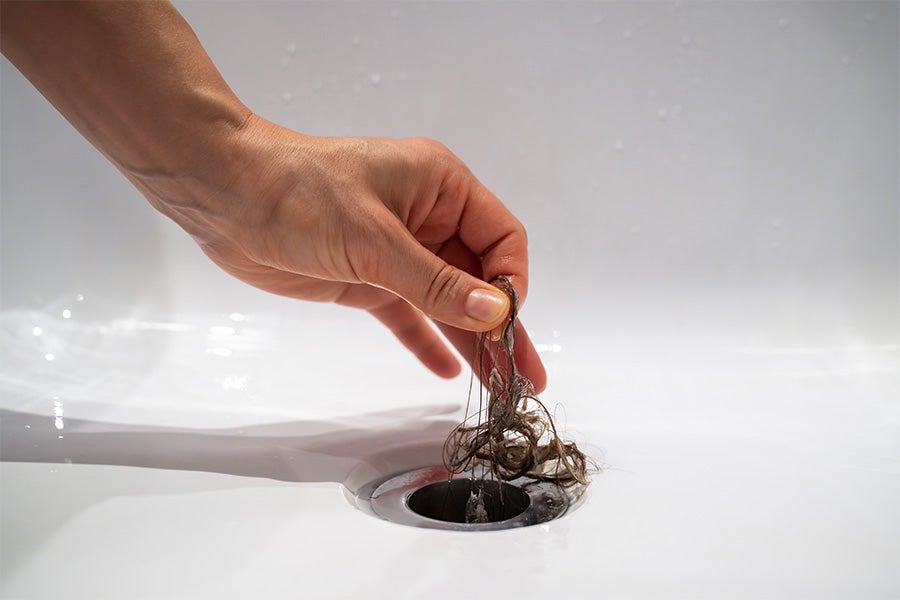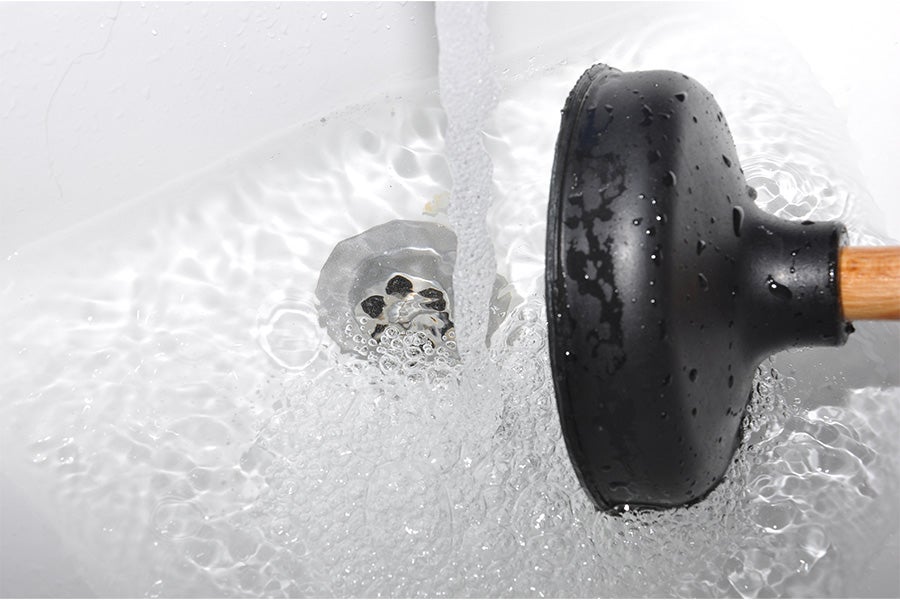Plumbing advice
What to do if your bathtub is draining slowly
24 Nov 2025 • 4 minutes

Plumbing advice
24 Nov 2025 • 4 minutes
Service Excellence Coach

There’s nothing more frustrating than stepping out of a relaxing bath only to find the water still lingering long after the plug has been pulled. A slow-draining bathtub might seem like a minor inconvenience at first, but if left unchecked, it could turn into a more serious plumbing problem.
In this guide, we’ll help you get to the bottom of what’s causing your bath to drain slowly and walk you through simple solutions you can try.
If your bath is draining slowly, there’s usually a clear reason behind it. Let’s take a look at the most common culprits.
Blockages in the pipes are the number one reason baths stop draining properly. Over time, things like:
…can all build up in the pipes, restricting water flow and causing backups.
If you live in a hard water area, minerals like calcium and magnesium can collect inside your pipes. These mineral deposits narrow the inside of the pipe over time, reducing drainage efficiency and increasing the chances of a full-on blockage.
Houses with older pipes are more prone to cracks and joint damage, which makes them vulnerable to tree root intrusion. Roots can grow into these tiny gaps in search of moisture, then expand and trap debris, causing slow drainage or full blockages that usually require a professional to fix.
As pipes get older (especially metal ones), they can start to corrode on the inside. This corrosion creates a rough surface where debris and sediment can build up, a bit like limescale in a kettle. Over time, that build-up can partially block the flow of water and slow things down.
Plumbing systems include vent pipes that allow air to flow and help drains function properly. If these vents become blocked (by leaves, animal nests, or other debris), it can cause negative pressure in your pipes, which results in slow drainage and gurgling sounds.
The good news is that many slow-draining baths can be fixed with a few DIY methods. Different clogs may respond better to different techniques, so you might need to try a few before finding what resolves the issue.

Start by inspecting the plughole. If you can see hair or gunk just below the surface, put on some gloves and try to pull it out using your fingers or a bent wire coat hanger. Be gentle, as you don’t want to damage the pipe or push the blockage further down.
This is a simple, eco-friendly method that can help to dissolve soap scum, grease, and minor build-ups. Boil a full kettle of water and let it cool slightly before slowly pouring it down the drain in stages.
Make sure to be careful if your plumbing uses plastic pipes, as pouring freshly boiled water directly into them can cause damage. If you're unsure what kind of pipes you have, it’s best to use warm (not boiling) water instead.

Place the plunger over the drain and make sure it’s sealed tightly. Fill the bath with enough water to cover the rubber part of the plunger, then push and pull firmly several times. The pressure can help dislodge stubborn clogs sitting deeper in the pipes.
Pour about half a cup of baking soda down the drain, followed by a cup of white vinegar. Cover the plughole with a cloth or plug and leave it to fizz for 15–30 minutes, then follow with boiling (or warm) water. This natural chemical reaction can help break down grease and grime.
A drain snake (sometimes also called a plumber’s auger) is a long, flexible tool that can reach deeper into pipes to pull out or break up clogs. Insert the snake into the drain, turn the handle to grab or loosen the blockage, then pull it out carefully.
As a last resort, you can try a commercial drain cleaner, but be cautious here. These products contain strong chemicals that can be harmful if misused or used too frequently, and they may damage older pipework. Make sure to always follow the manufacturer’s instructions and wear protective gloves when handling chemical cleaners.
Prevention is always better than a cure. With a few simple habits, you can help keep your bath draining freely and avoid repeat blockages.
Drain catchers (also known as hair catchers) sit over or inside the plughole to catch hair, soap bits, and debris before they go down the drain. Just remember to empty and rinse them regularly.
Clean your bath drain once a week by removing surface debris and flushing it with hot water. A monthly treatment with baking soda and vinegar can also help keep things flowing smoothly.
After using products like bath oils or thick soaps, run hot water down the drain for a minute or two. This helps melt away any lingering residue and prevents it from sticking to the inside of your pipes.
Body oils, heavy conditioners, bath bombs, and other thick or greasy toiletries can solidify in your pipes and contribute to clogs. Try to use them sparingly, and always follow up with a hot water flush if you do.
If you’ve tried all of the above methods and your bath is still draining slowly, it’s time to get a professional plumber in to help. Plumbers have the tools and expertise to diagnose more serious issues like tree root intrusions, collapsed pipes, or persistent blockages that you can’t reach yourself.
They’ll be able to inspect the system, remove the blockage safely, and ensure everything is running smoothly again.
At HomeServe, we know that plumbing problems don’t wait for a convenient time. That’s why our Plumbing and Drainage cover is designed to give you peace of mind, knowing that help is just a phone call away when you need it most.
Whether it’s a slow-draining bath or something more serious, our friendly, professional engineers are ready to fix it quickly and efficiently so you can get back to relaxing.
Liam has been working for HomeServe for over 18 years, starting as a water supply engineer then obtaining the required qualifications and venturing into Plumbing and Drainage, expanding his knowledge of the sector.
There are not many places left in England where Liam has not completed a job for HomeServe. He’s worked on water from 4” pipes to 15 mm pipes. One of his biggest jobs to date was installing the water supply pipe to one of the training pools for the Olympics in London 2012. Liam is now one of our Service Excellence Coaches, who help support our engineers in the field.
Why HomeServe?Liam has been with HomeServe for so long because of the commitment they have on being the best, striving to give the customers the best journey. Many businesses do not care about their staff, this is not the case at HomeServe who put it at the heart of what they do.
18 years working in Water Supply, Plumbing and Drainage.
Liam has been working for HomeServe for over 18 years, starting as a water supply engineer then obtaining the required qualifications and venturing into Plumbing and Drainage, expanding his knowledge of the sector.
There are not many places left in England where Liam has not completed a job for HomeServe. He’s worked on water from 4” pipes to 15 mm pipes. One of his biggest jobs to date was installing the water supply pipe to one of the training pools for the Olympics in London 2012. Liam is now one of our Service Excellence Coaches, who help support our engineers in the field.
Why HomeServe?Liam has been with HomeServe for so long because of the commitment they have on being the best, striving to give the customers the best journey. Many businesses do not care about their staff, this is not the case at HomeServe who put it at the heart of what they do.
18 years working in Water Supply, Plumbing and Drainage.
Our help & advice articles cover Plumbing, Home heating, Electrical, Energy-saving and Home maintenance.